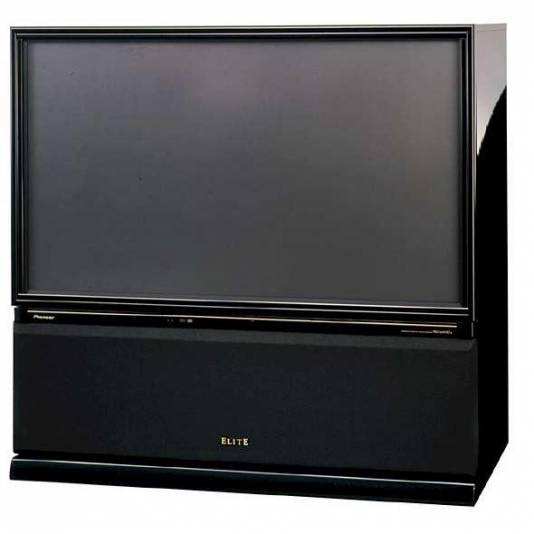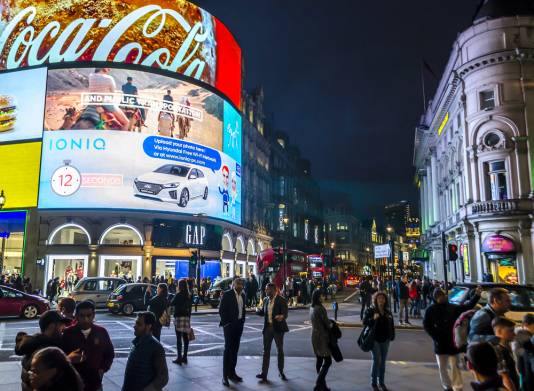Television screens have come a long way since the three-inch screens of the early 20th-century. From being an accessory of the elite, they are now one of the most common pieces of furniture in every home in the world.
In fact, “the telly” has actually shaped our lives and the design of our homes to accommodate it. The television counts among a handful of designs which have most dramatically changed 20th-century society. The design has evolved massively since the boxy retro contraptions of yesteryear, like the Emyvisor (below) and the Marconi. With flatscreens and high-definition displays that can seem crisper and more colourful than reality itself, 21st-century viewers are comparatively spoiled.

Huge step, small screen
The modern television’s earliest ancestor was the Octagon, made by General Electric in 1928. It used a mechanical, rotating disc technology to display images on its three-inch screen. While it was never mass-produced, it played what is widely considered the world’s first television drama: “The Queen’s Messenger.” And viewers probably had to sit about three inches from the screen to fully enjoy the ‘spectacle!’

This primitive technology quickly evolved into commercially available home TV sets, accessible, at first, only to those with deep pockets. Designers knew how revolutionary television would be, and advertisers milked the technology’s novelty in ways that now seem dated: as the 1936 Cossor Television was advertised in a brochure: “Radio – its thrills, its interests, increased one hundred-fold by Television. . . Radio is blind no longer. The most exciting running commentary is made immeasurably more thrilling when you can SEE too!”
Behind closed doors
The Cossor came in a walnut cabinet, and the screen was hidden behind two sturdy doors when not in use – like a portal to a secret, privileged world! This feature was largely retired in later designs, as were round screens, seen in 1949’s Raytheon TV, and the built-in legs seen on sets in the ’50s and ’60s.

The TV has become a piece of furniture as commonplace as the dinner table and far more worshipped. Furniture is positioned specifically in order to get the best view of the television, and many homes have televisions in several rooms. As popularity has boomed, prices have plummeted, meaning that the vast majority of people now possess more than one. In the USA, 6000 TV sets were in use in 1946, and this rose to more than 12 million in just five years.
In the mid-1990s rear projection televisions hit the mainstream market. This Pioneer Elite 65in model of 1995 was the cream of the crop. The TVs offered huge screen sizes and a much slimmer profile than the now-bulky CRT.

The next evolution for televisions was the introduction of 100Hz frame-doubling technology. This created interpolated frames to smooth out the motion blur and jitteriness that plagued early LCD models.
This Keracolour set of 1970 (below) has a striking design, enclosing the picture tube in a spherical white shell.

Televisions of the 1980s were not very exciting. This was the age of bundled remote controls (instead of being charged extra for the remote).

A few years later plasma technology came into the limelight. Fujitsu claim to have introduced the first plasma TV in 1992.

By 2005, the CRT was dead — and rear projection died along with it. Almost all televisions sold were flat-panel LCD and plasma screens. Only a few inches thick and with picture quality and resolutions never seen before, this new technology led to a boom in TV sales. This Panasonic Viera TH-42PV500 (below) was a popular choice.

8K TVs
Yes, the future’s already here – but there’s nothing to watch!

Unlike some other modern TV technologies 8K is simple to understand. An 8K TV has four times the number of pixels of a 4K TV, which, in turn, has four times the number of pixels of an HD TV. That’s easy to visualise.
The details
The resolution on an 8K TV is 7,680 x 4,320 for a total of 33,177,600 pixels. This huge number of pixels means an 8K TV can display incredibly sharp, detailed images that show more detail than a 4K TV could ever manage. In fact, we’re getting to the stage where the human eye is at its optimum viewing level.
However, we’re in the early stages of 8K TVs. Only LG, Samsung, Sharp and Sony have announced 8K sets that you’re able to buy, and, like all new technology, it’s always expensive for the first few years of production. Samsung’s cheapest range starts at around £4,999 for the 65-inch set while models from rival brands are all bigger and will cost more as a result. That’s a lot of money, but here comes the rub…
Move to Japan!
No 8K Blu-rays, no 8K streaming services and no 8K channels. The only way to watch something in 8K would require you to move to Japan – and to be honest, unless you can speak Japanese, you’ll be none the wiser. The pictures will look amazing though!
In Japan national broadcaster NHK is trialling an 8K channel, and the only alternative is to purchase an extremely expensive 8K camera and make your own programmes. But – and this isn’t a surprise – the companies making the content are always playing catch-up with the TV technology. It was the same when 4K TVs were first launched. So, it’s going to take time to get there… we just hope that you can wait!
Screens and new technology
As TVs have developed, so have the ways in which screens are used in marketing and for information purposes.

This may not be one of the better changes caused by technology, yet it’s certainly significant. The viewer’s ability to choose video content and zero in on specific excerpts has changed the way we consume television. As a result, there has been an increased focus on condensed versions, snippets and soundbites. Everything seems like an advert for something. Unfortunately, this method of consumption has been the cause of confusion and distortion. By focusing on five-to-10-second clips of video, it’s possible to lose context. Of course, that’s less important in entertainment programming, versus in news, where full content can be critical.
New Competition
TV was never intended to be an interactive medium. For decades, it talked, whilst we sat and listened – until social media, especially Twitter, came along. Rather than idly watching, social media has given people a new type of voice, allowing them to connect and discuss shows in real time. Both sports and news talk shows have capitalised on this ability, and many are integrating it into their programming and advertising.
The future
When viewers constantly engage with their mobile phone whilst ‘watching’ TV, experts call this phenomenon “second screen,” and for younger viewers, engaging with a mobile during TV time is practically a given. Do people still have the capacity to actually just sit and watch a programme on its own merits? A two-hour movie seems increasingly difficult for younger people to handle. Many have to consult their own miniature screen on their mobile to see what they’re missing out on. And that’s usually nothing!

The Piccadilly Lights
The huge display screen in London’s Piccadilly Circus is one of the most instantly recognisable landmarks in the UK, and around the world. The very first advertising campaign was in 1908 – in poster form, and the site has become the country’s most recognisable advertising space – these days using huge outdoor digital screens to get its message across.
The first illuminated advertising hoardings appeared, used by the first advertiser – Perrier.
Over the years, the site has become associated with the latest technological advances as new tech developments have been unveiled to the masses. In 1923, Bovril was the big advertiser of the new electric billboards.

Here comes neon
The original lightbulbs were later replaced by neon lights and then by digital projectors in 1998. The 2000s saw the introduction of LED displays, which by 2011 had completely replaced the iconic neon lamps. The biggest transformation of all happened in 2014 when the digital revolution arrived!
Landsec, owner of the site has invested heavily in recent years, culminating in the relaunch as one single screen in October 2017
Richard Malton, chief marketing officer at Ocean, which has managed the Piccadilly Lights site since 2016 told Campaign magazine, “Not only was it significant for Piccadilly, it was a reboot which turned one of London’s most famous landmarks and tourist attractions into an enabler for global brands to communicate with a global audience – a stage unprecedented and unrivalled.”
The old patchwork of screens set-up was replaced single 783.5m2 LED digital screen – the largest of its kind in Europe. Each pixel is 8mm from the next which means that it has a resolution 1.4x greater than 4K LED – equivalent to a 1,000-inch-wide TV screen – and is capable of producing more than 281 trillion colours. You’d need a pretty big lounge to fit it in.
Live streamed
When the new screen was launched, more than 12 million people watched the live stream on YouTube and Facebook. The Piccadilly lights are well-known around the world, not least because of its regular depiction in movies.

Many leading brands have rented the space, including Coca-Cola which first appeared there in 1955. Tech giant Sanyo is also closely associated with the Piccadilly Lights site having first advertised there in 1978. Sanyo took one of the five permanent spots (each known as a ‘light’) until 2011 when it was replaced by Hyundai – the first new company to appear in 17 years.
Other huge brands such as Guinness, TDK, Kodak, Nescafe and McDonald’s also appeared there. When the relaunch came about on 2017 eBay, Hunter, Hyundai, Coca-Cola, L’Oreal Paris and Stella McCartney were the six brands which took space. The rotation of these companies’ digital adverts recreated the original patchwork via state-of-the-art technology.
20th Century Fox got in on the act months later, by creating a trailer for the movie Deadpool 2 which was specifically designed for the location and specifically targeted at London.
When it comes to attracting publicity, The Kardashian family are never far away, and they became the only people to appear on the site twice within a single year with campaigns for Calvin Klein.
The excitement of the Piccadilly location has even got to the brand owners themselves, with eBay flew board members from the US to the UK just to see their ad in situ, and board members from Stella McCartney also visited the site for design inspiration.

The 790 square meter screen is also fitted with hidden cameras which will analyse the make, model, and colour of cars that drive by as well as the age, gender, and even the feelings of nearby pedestrians in order to customise ads for the local audience. The technology can be used to program certain ads to play when specific cars drive past, for example, or in response to weather changes, or news and sport reports. The new screen will also provide complimentary Wi-Fi for people in the surrounding area.
The Piccadilly Lights have seldom gone dark. They did so for the funerals of Winston Churchill and Diana Princess of Wales, and let’s not forget they also went out for the ‘blackout’ during WW2. The Piccadilly Lights have become a meaningful symbol for the capital and people of the UK and many people see it as the beating heart of London. Not bad for an advertising space.
Other types of display screen uses…
Anyone who has watched a sporting event on TV or from inside the stadium have witnessed the LED scrolling advertising ‘boards’ which show animated text, graphics and advertisers’ logos to dynamic effect. The adverts can be stunning and eye catching, and the main advantage is that many advertisers can be displayed on this electronic billboard display, giving a greater potential for revenue.
Other types of LED displays include art installations, concert venue backgrounds, creative lighting and nightclub floor screens amongst others…
TVs and Resilience
Despite all the new forms of ‘screen entertainment’, it’s still TV which has the greatest impact when it comes to advertising.

Trust and impact
Research by The Global TV Group reveals that TV is the most trusted form of advertising and remains most likely to make consumers laugh, move them to tears or trigger emotions.
For example: TV is by far the most trusted form of video advertising in Canada. 70% of 18-34 year-olds named TV the most trustworthy compared to 12% for online video.
In the UK, 42% stated television is where they are most likely to find advertising that they trust in comparison to 6% for YouTube and 5% for social media.
Reach: TV reaches approximately 70.1% of Europe’s population daily and average daily viewing time is 3hrs 39mins. It is the unique combination of this reach together with the huge volume of time spent watching TV that makes it such a powerful form of advertising. For example:
*In Finland, television reaches 95.6% of the population within a month.
*Television still reaches 99.2% of the Portuguese population weekly.
These are still incredibly high figures in 2021.
Large format displays
Large format screens have long been used in a variety of applications that make the most of their advantages on a grand scale. You’ve seen them in shopping centres, in shop windows, and even on the side of some bus shelters. Recent innovations in display technology have given rise to certain developments that have changed the face of large format screen technology forever.

An ideal display solution to convey scale and gravitas, large format projection is an easy way to send a message to your customers that you are a credible and large organisation – an organisation that can be trusted.
According to the Outdoor Advertising Association of America (OAAA), in 2018, the top spenders, in terms of out-of-home advertisements, included Geico, Netflix, Google, American Express, Apple, McDonalds, T-Mobile, Amazon, M&Ms, Facebook, and Universal Pictures, among others, with Apple and McDonalds retaining their top spots.
Versatile technology
At the time of the COVID-19 pandemic, businesses are focusing on the innovation based on touchless technologies for the interactive large format displays. Large display interaction using hover and capacitive imaging of all objects and people near the display surface is an intuitive new way to interact. That’s the future!



